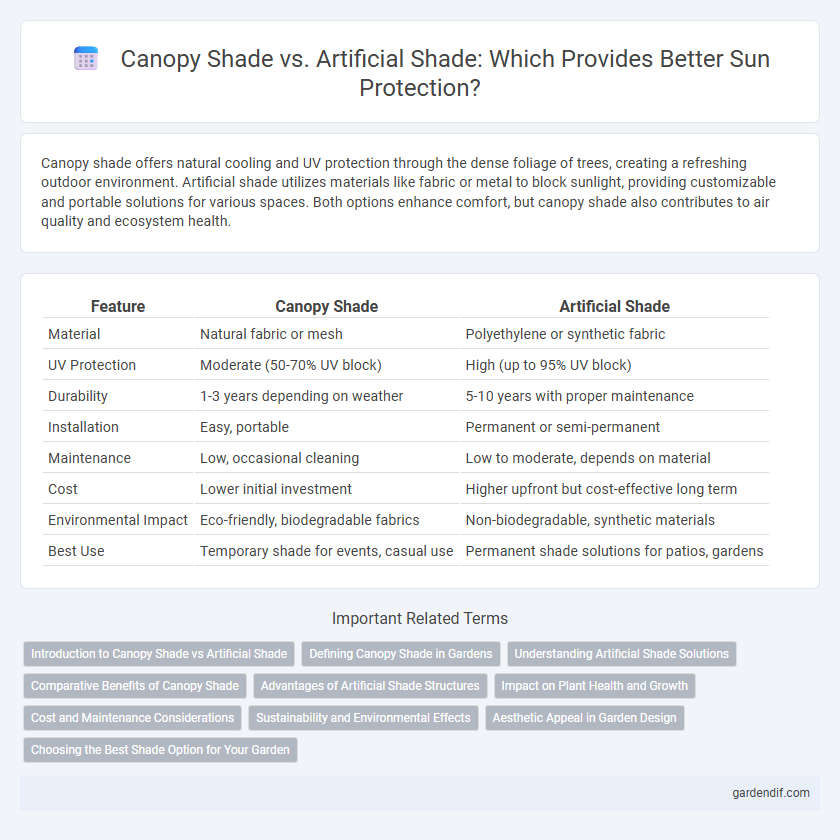
Canopy Shade vs Artificial Shade Illustration
Canopy shade offers natural cooling and UV protection through the dense foliage of trees, creating a refreshing outdoor environment. Artificial shade utilizes materials like fabric or metal to block sunlight, providing customizable and portable solutions for various spaces. Both options enhance comfort, but canopy shade also contributes to air quality and ecosystem health.
Table of Comparison
| Feature | Canopy Shade | Artificial Shade |
|---|---|---|
| Material | Natural fabric or mesh | Polyethylene or synthetic fabric |
| UV Protection | Moderate (50-70% UV block) | High (up to 95% UV block) |
| Durability | 1-3 years depending on weather | 5-10 years with proper maintenance |
| Installation | Easy, portable | Permanent or semi-permanent |
| Maintenance | Low, occasional cleaning | Low to moderate, depends on material |
| Cost | Lower initial investment | Higher upfront but cost-effective long term |
| Environmental Impact | Eco-friendly, biodegradable fabrics | Non-biodegradable, synthetic materials |
| Best Use | Temporary shade for events, casual use | Permanent shade solutions for patios, gardens |
Introduction to Canopy Shade vs Artificial Shade
Canopy shade uses natural fabric or mesh materials to block sunlight, providing breathable and eco-friendly protection for outdoor spaces. Artificial shade, consisting of synthetic structures like umbrellas or metal pergolas, offers durability and design flexibility but often lacks the cooling benefits of natural shade. Understanding these differences helps in selecting the appropriate shading method for comfort, aesthetics, and environmental impact.
Defining Canopy Shade in Gardens
Canopy shade in gardens refers to the natural cover provided by the upper layer of tree branches and foliage, which filters sunlight and creates a cooler microclimate beneath. This organic shade supports biodiversity by offering habitat for various species and enhances soil moisture retention, contributing to healthier plant growth. Unlike artificial shade structures, canopy shade evolves with the ecosystem, adapting dynamically to seasonal changes and weather conditions.
Understanding Artificial Shade Solutions
Artificial shade solutions use materials such as high-density polyethylene fabric and UV-resistant mesh to provide consistent protection from harmful solar rays. These structures often include retractable awnings, shade sails, and pergolas designed to block up to 90% of UV radiation while ensuring airflow and durability. Compared to canopy shade, artificial options offer customizable coverage, enhanced longevity, and require less maintenance, making them ideal for both residential and commercial outdoor spaces.
Comparative Benefits of Canopy Shade
Canopy shade offers natural cooling by blocking sunlight with tree leaves, reducing temperatures by up to 10 degrees Fahrenheit, whereas artificial shade relies on materials that absorb and radiate heat. Canopy shade enhances air quality and supports biodiversity, providing habitat for birds and insects, benefits not matched by synthetic structures. Furthermore, canopy shade contributes to carbon sequestration, helping mitigate climate change, while artificial shade lacks ecological functions.
Advantages of Artificial Shade Structures
Artificial shade structures offer consistent protection from harmful UV rays regardless of weather conditions, ensuring reliable comfort in outdoor spaces. These structures are customizable in design and size, allowing for versatile applications in residential, commercial, and recreational environments. Their durability and low maintenance requirements provide long-term cost-effectiveness compared to natural canopy shade.
Impact on Plant Health and Growth
Canopy shade provides natural filtering of sunlight, promoting balanced photosynthesis and aiding in temperature regulation crucial for plant health and growth. In contrast, artificial shade can limit light exposure and disrupt natural growth cycles, potentially stunting development and reducing overall plant vitality. The microclimate created by canopy shade also supports soil moisture retention and beneficial microorganisms, enhancing plant resilience and productivity.
Cost and Maintenance Considerations
Canopy shade, formed by natural trees, offers long-term cost savings with minimal maintenance after initial planting, while artificial shade structures require upfront investment and periodic upkeep such as cleaning and repairs. Canopy shade enhances property value and reduces cooling costs naturally, whereas artificial shade may incur additional expenses due to materials and replacement parts over time. Choosing between canopy and artificial shade involves weighing initial costs against ongoing maintenance efforts and the environmental benefits of green shade.
Sustainability and Environmental Effects
Canopy shade, created by trees and plants, offers natural cooling and carbon sequestration, significantly reducing urban heat islands and improving air quality. Artificial shade structures, typically made from synthetic materials like plastics and metals, often have a higher carbon footprint due to manufacturing and limited recyclability. Choosing canopy shade supports biodiversity and sustainability goals by enhancing ecosystems, while artificial shade can contribute to environmental degradation without proper sustainable design considerations.
Aesthetic Appeal in Garden Design
Canopy shade provides a natural, organic aesthetic that enhances garden design with its dynamic play of light and shadow, creating a serene and inviting atmosphere. Artificial shade structures, while customizable in color and shape, often lack the vibrant texture and seasonal variation that living canopies offer. Gardens with canopy shade benefit from the integration of natural elements that promote biodiversity and complement surrounding plantings.
Choosing the Best Shade Option for Your Garden
Canopy shade offers natural cooling and enhances garden aesthetics through living trees, promoting biodiversity and cleaner air. Artificial shade solutions, such as shade sails or pergolas, provide customizable coverage and immediate protection from UV rays without relying on plant growth. Assess factors like maintenance, environmental impact, and desired durability to determine the optimal shade option for your garden's specific needs.
Canopy Shade vs Artificial Shade Infographic

 gardendif.com
gardendif.com